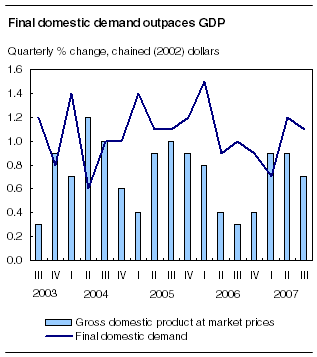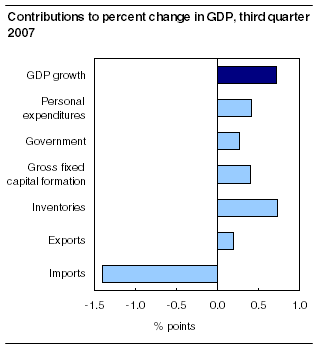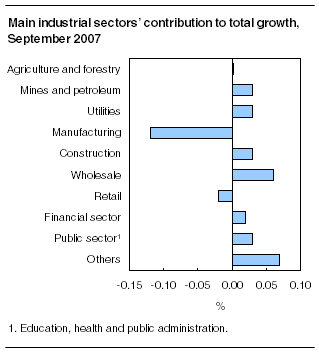Common menu bar links
Canadian economic accounts
Archived Content
Information identified as archived is provided for reference, research or recordkeeping purposes. It is not subject to the Government of Canada Web Standards and has not been altered or updated since it was archived. Please "contact us" to request a format other than those available.

Economic growth moderated in the third quarter as real gross domestic product (GDP) advanced 0.7%, down from 0.9% in the second quarter. Economic output was up 0.1% in September, after increasing 0.2% in August and 0.1% in July. Final domestic demand remained buoyant (+1.1%), outpacing GDP for the 11th quarter in the past 12.

A more detailed analysis is available in Canadian Economic Accounts Quarterly Review.
Consumer spending eased in the third quarter from its robust showing in the second, while retailers and wholesalers added significantly to their inventories. Imports outpaced exports by a wide margin, as the Canadian dollar once again appreciated sharply (+5.1%) against its US counterpart.
Businesses took advantage of lower prices to invest heavily in machinery and equipment. Housing investment remained strong, propelled by new home construction, while the resale market retreated.

The output of the service industries expanded 0.9% in the third quarter, while the production of the goods industries contracted 0.1%. Significant growth was recorded in wholesale trade. Finance and insurance, construction, mining, and accommodation and food services also contributed to the overall increase. These gains were partly offset by declines in manufacturing, utilities, and forestry and logging.
Labour income grew at a slower pace than in the first half of 2007, while personal disposable income was up moderately. Corporate profits advanced on strong bank earnings.
The Canadian economy grew at an annualized rate of 2.9% in the third quarter, compared with 4.9% for the US economy.
Note to readersPercentage changes for expenditure-based and industry-based statistics (such as consumer expenditures, investment, exports, imports and output) are calculated using volume measures, that is, adjusted for price variations. Percentage changes for income-based statistics (such as labour income, corporate profits and farm income) are calculated using nominal values, that is, not adjusted for price variations. |
| Real gross domestic product, chained (2002) dollars1 | |||||
|---|---|---|---|---|---|
| Change | Annualized change | Year-over-year change | |||
| % | |||||
| First quarter 2006 | 0.8 | 3.4 | 3.6 | ||
| Second quarter 2006 | 0.4 | 1.5 | 3.1 | ||
| Third quarter 2006 | 0.3 | 1.3 | 2.4 | ||
| Fourth quarter 2006 | 0.4 | 1.5 | 1.9 | ||
| First quarter 2007 | 0.9 | 3.5 | 1.9 | ||
| Second quarter 2007 | 0.9 | 3.8 | 2.5 | ||
| Third quarter 2007 | 0.7 | 2.9 | 2.9 | ||
| |||||
Industrial production (the output of utilities, mines and factories) slipped 0.4% in the third quarter as utilities and manufacturing both declined. Mining moved forward as a result of the increase in oil and gas exploration and metal ore mining. In comparison, all three sectors increased in the United States, resulting in an overall gain of 1.1% for the quarter.
Economy-wide prices in Canada, as measured by the chain price index for GDP, edged down 0.3% in the third quarter, partly as a result of lower prices for energy exports. Excluding energy, economy-wide prices were up 0.2%, after a 1.5% increase in the second quarter.
Pace of consumer spending eases
Growth of consumer spending eased to 0.7% in the third quarter, less than half the pace posted in the second quarter and the weakest gain in two years.
After increasing 3.9% in the second quarter, consumer purchases of new and used motor vehicles were down a sharp 2.6% in the third. Spending was also down on motor vehicle parts and repairs as well as on motor fuels. Consumption of electricity, natural gas and other fuels all declined.
Continued strength in the housing market stimulated spending on household furniture and appliances. Outlays were also strong on recreational, sporting and camping equipment and on clothing and footwear.
Consumption of services was up 1.1% in the third quarter, matching its pace in the second. Net expenditure abroad was up sharply for a second consecutive quarter, as the stronger dollar boosted Canadians' travel spending abroad (which includes cars and trucks purchased in the United States and brought back) and restrained spending by visitors to Canada.
Large build-up of inventories
Businesses added $15 billion worth of goods and materials to their non-farm inventories in the third quarter, following two quarters of small increases.
Retailers accounted for just over $9 billion of the inventory accumulation, with motor vehicles responsible for nearly half of the build-up. Wholesalers also added significantly to their inventories of motor vehicles and machinery and equipment.
Despite a 0.7% reduction in output, manufacturers built up stocks for the second consecutive quarter as higher inventories of finished goods more than offset lower inventories of raw materials.
Farm inventories dwindled for the third consecutive quarter, as farmers sold off grains at prices driven higher by demand for bio-fuels.
Imports outpace exports by wide margin
Imports of goods and services jumped 4.4% in the third quarter, following a 1.9% gain in the second. Imports have outpaced exports now in 12 of the past 17 quarters.
Machinery and equipment imports jumped 6.4% as Canadian businesses invested heavily in new machinery and equipment. Aircraft, engines and parts led in this category. Automotive products and other consumer goods were both up sharply.
Travel imports were up sharply for the second consecutive quarter as the soaring loonie stimulated Canadians' travel spending abroad.
Exports of goods and services increased 0.6% in the third quarter, after growing 0.8% in the second.
Exports of industrial goods and materials were up 4.5%, the strongest pace in a year, driven notably by higher shipments of nickel ores. Shipments of automotive products were up 2.0%, rebounding from two consecutive quarters of declines. Exports of energy products advanced 1.4% on increased oil and natural gas deliveries to the United States.
Labour disputes in the British Columbia forestry sector, as well as continued softening in US residential construction, contributed to a sharp 6.2% drop in forestry exports. The output of the forestry and logging industry slid 7.2%.
Heavy investment in machinery and equipment
Business investment in machinery and equipment picked up steam in the third quarter, advancing 3.6%, more than twice the pace set in the second quarter and the fastest pace in 10 quarters.
Investment in other transportation equipment jumped 14%, owing mainly to capital outlays by the airline industry. Outlays for telecommunications, computers and other office equipment and software posted solid increases.
On the downside, capital outlays for trucks slipped 2.8%, their third consecutive decline.
Continued gains in housing investment
Investment in housing posted another solid gain during the third quarter. Over the past three quarters, total investment in residential structures has grown 4.8%, compared with a decline of 2.9% over the preceding three quarters.
The strength in housing stemmed from new residential construction. Renovation activity gave an added boost, advancing 1.2% in the third quarter, twice its pace in the second.
The resale market cooled over the summer months, as ownership transfer costs (which include real estate commissions) slipped 1.6%, following two quarters of solid gains.
Labour income slows from first half of 2007
Labour income advanced 0.5% in the third quarter, less than one-third its pace in the first and second quarters, when special pay equity payments in Quebec and special pension contributions in Newfoundland and Labrador boosted labour income.
Excluding these special payments, labour income would have grown 1.2% in the third quarter, 1.6% in the second and 1.8% in the first.
Corporate profits boosted
Corporation profits before taxes increased 2.6%, the fastest pace in nearly two years. Profits were boosted by earnings in the banking sector. The oil and gas extraction industry, petroleum refineries and coal products, retailers and wholesalers also fared well.
Lower exports and labour disruptions in the British Columbia forestry sector contributed to lower profits for wood and paper producers, while lower commodity prices reduced profits in mining (excluding mineral fuels).
Gross domestic product by industry, September 2007
Economic activity was up 0.1% in September, after increasing 0.2% in August and 0.1% in July. The gain recorded by the service producing industries (+0.2%) was partially neutralized by the decrease in the production of goods (-0.1%). Increases in the energy sector and wholesale trade propelled the growth, while a decline in manufacturing and retail trade dampened it. Gains were also registered in construction and in the accommodation and food services sector. The finance and insurance sector and metal ore mining were additional sources of declines.

Wholesale trade rose 1.0% in September, for a fifth consecutive monthly increase. Gains were posted in the wholesaling of food and beverages, motor vehicles, and building supplies. These gains were dampened by declines in the wholesaling of oilseeds and grains, computer and other electronic equipment, lumber and millwork, and office and professional equipment. After a very strong showing in August, retail trade experienced a slight decrease of 0.3% in September.
| Monthly gross domestic product by industry at basic prices in chained (2002) dollars | ||||||||||
|---|---|---|---|---|---|---|---|---|---|---|
| April 2007r | May 2007r | June 2007r | July 2007r | August 2007r | September 2007p | |||||
| Seasonally adjusted | ||||||||||
| Month-to-month % change | ||||||||||
| All industries | 0.0 | 0.4 | 0.2 | 0.1 | 0.2 | 0.1 | ||||
| Goods-producing industries | 0.0 | -0.2 | 0.2 | -0.2 | 0.1 | -0.1 | ||||
| Service-producing industries | 0.1 | 0.7 | 0.2 | 0.3 | 0.2 | 0.2 | ||||
| Industrial production | 0.1 | -0.4 | 0.2 | -0.2 | -0.1 | -0.3 | ||||
| Manufacturing | -0.1 | 0.1 | -0.7 | 0.3 | -0.4 | -0.9 | ||||
| Wholesale trade | -0.7 | 1.9 | 0.4 | 1.4 | 0.1 | 1.0 | ||||
| Energy sector | 0.4 | -1.3 | 1.7 | -0.9 | 0.0 | 0.8 | ||||
| ||||||||||
Manufacturing retreated 0.9% in September, on the heels of declines in August and June, while the Canadian dollar appreciated vis-à-vis the US currency. The production of non-durable goods (-0.7%) and durable goods (-0.9%) declined. Of the 21 major manufacturing groups, 16 decreased, these accounting for 78% of total manufacturing value added.
The energy sector advanced 0.8% in September, after remaining unchanged in August. Electricity production jumped 1.7% in September, while natural gas production posted a slight increase and crude oil production slipped. Oil and gas exploration moved ahead (+3.7%) for the fourth month in a row, but still remains well below the level of activity recorded in early 2007.
The construction sector advanced 0.4% in September, a fifth consecutive monthly increase. The gains recorded in residential construction (+0.8%) and engineering and repair work (+0.3%) overshadowed the modest slip in non-residential building construction (-0.1%).
Industrial production (the output of mines, utilities and factories) retreated 0.3% in September. The gains in utilities and mining were not enough to offset the decline in manufacturing. In the United States, industrial production increased 0.2% in September. Both manufacturing and mining moved ahead, while utilities fell.
Products, services and contact information
Detailed analysis and tables
The National economic accounts module, accessible from the home page of our website, features an up-to-date portrait of national and provincial economies and their structure.
More detailed analysis on today's releases from the national accounts, including additional charts and tables, can be found in the third quarter 2007 issue of Canadian Economic Accounts Quarterly Review, Vol. 6, no. 3 (13-010-XWE, free), now available from the Publications module of our website.
Gross domestic product by industry
Available on CANSIM: table 379-0027.
The September 2007 issue of Gross Domestic Product by Industry, Vol. 21, no. 9 (15-001-XWE, free) is now available from the Publications module of our website.
For general information or to order data, contact our dissemination officer (toll-free 1-800-887-4623; iad-info-dci@statcan.gc.ca). To enquire about the concepts, methods or data quality of this release, contact Bernard Lefrançois (613-951-3622), Industry Accounts Division.
National economic and financial accounts
Available on CANSIM: tables 378-0001, 378-0002, 380-0001 to 380-0017, 380-0019 to 380-0035, 380-0056, 380-0059, 380-0060 and 382-0006.
Definitions, data sources and methods: survey numbers, including related surveys, 1301, 1804, 1901 and 2602.
The third quarter 2007 issue of National Income and Expenditure Accounts, Quarterly Estimates (13-001-XIB, free) will soon be available.
Detailed printed tables of unadjusted and seasonally adjusted quarterly National Income and Expenditure Accounts (13-001-PPB, $54/$193), Financial Flow Accounts (13-014-PPB, $54/$193) and Estimates of Labour Income (13F0016XPB, $22/$70), including supplementary analytical tables and charts are now available.
At 8:30 a.m. on release day, the complete seasonally adjusted quarterly National Income and Expenditure Accounts (13-001-DDB, $134/$535), Financial Flow Accounts (13-014-DDB, $321/$1,284), and monthly Estimates of Labour Income (13F0016DDB, $134/$535) data sets can be obtained on computer diskette.
These diskettes can also be purchased at a lower cost seven business days after the official release date (13-001-XDB, $27/$107; 13-014-XDB, $65/$257; and 13F0016XDB, $27/$107). To purchase any of these products, contact Client Services (613-951-3810; iead-info-dcrd@statcan.gc.ca), Income and Expenditure Accounts Division.
For more information, or to enquire about the concepts, methods or data quality of this release, contact the information officer (613-951-3640, iead-info-dcrd@statcan.gc.ca), Income and Expenditure Accounts Division.


 Table(s).
Table(s).